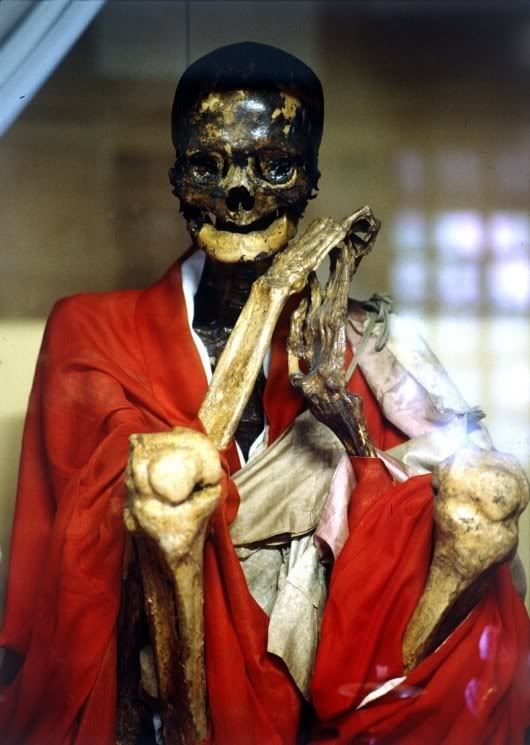"Once upon a time, I, Chuang Chou, dreamt I was a butterfly, fluttering hither and thither, to all intents and purposes a butterfly. I was conscious only of my happiness as a butterfly, unaware that I was Chou. Soon I awaked, and there I was, veritably myself again. Now I do not know whether I was then a man dreaming I was a butterfly, or whether I am now a butterfly, dreaming I am a man." -- Zhuangzi
Saturday, November 5, 2011
Monks, Meditation, and Mummies
In honor of Halloween (which is actually also the anniversary of Martin Luther pounding his 95 theses on the door of the church in Wittenberg in 1517), I have dedicated a post to the mysterious mummified monks of Japan. While we are all familiar with the mummies of Egyptian acclaim, I argue that these mummies of northern Japan are more remarkable. Why? Because they didn't wait to die to be mummified; they did it themselves as the ultimate expression of devotion.
Labels:
Alicia Cutler,
Buddhism,
burial,
Japan,
ritual,
Sokushinbutsu
Friday, November 4, 2011
Symbols and Codes.
We discussed in class a little bit yesterday the correlation between a literary system and a numeracy system. As soon as writing developed, written numbers were used to keep track of business transactions and other records. In fact, most artifacts that we have today are records of accounting.
 |
| The oldest tablet found in Europe, written in the Mycenaean Linear B System. It records business transactions. |
But can letters and numbers have other correlating purposes? Of course, they both can be used to create a code, or a system of secrecy or multiple representation in which certain words, letters, or numbers are assigned different meanings.
The Ancient Greeks, for example, actually used there letters as symbols of numbers. Their alphabet served a dual purpose. It communicated thoughts and ideas, but also stood as representation of a number in many cases. Today, we still use letters of the Greek alphabet to represent numbers which we plug into formulas (or mathematical codes) such as Alpha, Beta, Gamma, Phi and Pi.
Similarly, the Roman alphabet, or the Latin alphabet, which is the most recognized alphabet in the world today, evolved from a Western variety of the Greek alphabet. This alphabet, along with Arabic numerals, is the basis of what is perhaps the most common code today, Morse Code. This code is unique in that it can be used through almost any kind of medium; sound, written, visual.
Just for fun, I created my own code using numbers as letters. See if you can decipher what this says and you'll discover an interesting fact about me!
23...15.1...6.19.26.15.8.19.18...8.3...21.3.6.18.3.2...16...22.23.2.17.25.26.19.13...
Labels:
Codes,
Letters,
Misa Morreall,
Numbers,
Reinventing Knowledge,
Written Knowledge
Thursday, November 3, 2011
ABRACADABRA
 |
| The word abracadabra - in it's earliest known use - was written in this pattern and worn around the neck or sewn into clothing in order to cure fever. |
Labels:
abracadabra,
Hebrews,
magic,
Michael Miles,
religion,
runes,
spells,
the occult,
words,
Writing
Tuesday, November 1, 2011
Questions, With No Real Answers
So what does it mean to "write it down"? To save a piece of information by putting it in a book, on a sticky note, or in a planner? To write/(take) notes instead of just listening? To send a handwritten letter or card, as opposed to a store-bought one, or even an email? How does the significance of writing versus memorization compare in our time? How would it have compared in the time periods we are discussing?
I really didn't do much research for this post, but I am enjoying the thought experiment. "Critically" thinking about what we have learned about writing so far, and how it has changed our perspective on the world, and how it must have changed the ancients' perspectives. So I am basically answering the previous questions with my personal, educated opinions, and I want this post to open the blog to yours too.
I really didn't do much research for this post, but I am enjoying the thought experiment. "Critically" thinking about what we have learned about writing so far, and how it has changed our perspective on the world, and how it must have changed the ancients' perspectives. So I am basically answering the previous questions with my personal, educated opinions, and I want this post to open the blog to yours too.
Labels:
Education,
Knowledge Institutions,
Memorization,
Morgan Mix,
Oral Knowledge,
oral tradition,
Philosophy,
Reinventing Knowledge,
Teaching,
Writing,
Written Knowledge
Monday, October 31, 2011
Calligraphication
So as I posted earlier, I tried my hand at calligraphy, but without training I did not do a very good job. We decided as a group to go over to Alicia's house last Friday and she taught us all about inks, papers, nibs, scripts, and everything you could ever want to know about calligraphy. It turns out she's quite the expert. We documented the experience with photos so I could post it here.
Everyone can please add to this post or put their 2 cents about the experience in a comment.
A preview behind the mystery of Facsimile 2

I have an unquenchable curiosity. I am intrigued by all things mysterious and unknown. For this reason I chose to discuss the occult. To me the Pearl of Great Price from the LDS canon encapsulates the word occult very well. More specifically those mysterious "drawings" we all loved to look at growing up but never had any clue what they meant illustrate the concept occult very well. So lets debunk some (but not all, it wouldn't fall under "the occult umbrella" if we knew everything about it) of the mystery....
Labels:
Book of Abraham,
Egypt,
Egyptian,
Facsimile,
Facsimile 2,
the occult,
William Myers
Subscribe to:
Comments (Atom)

